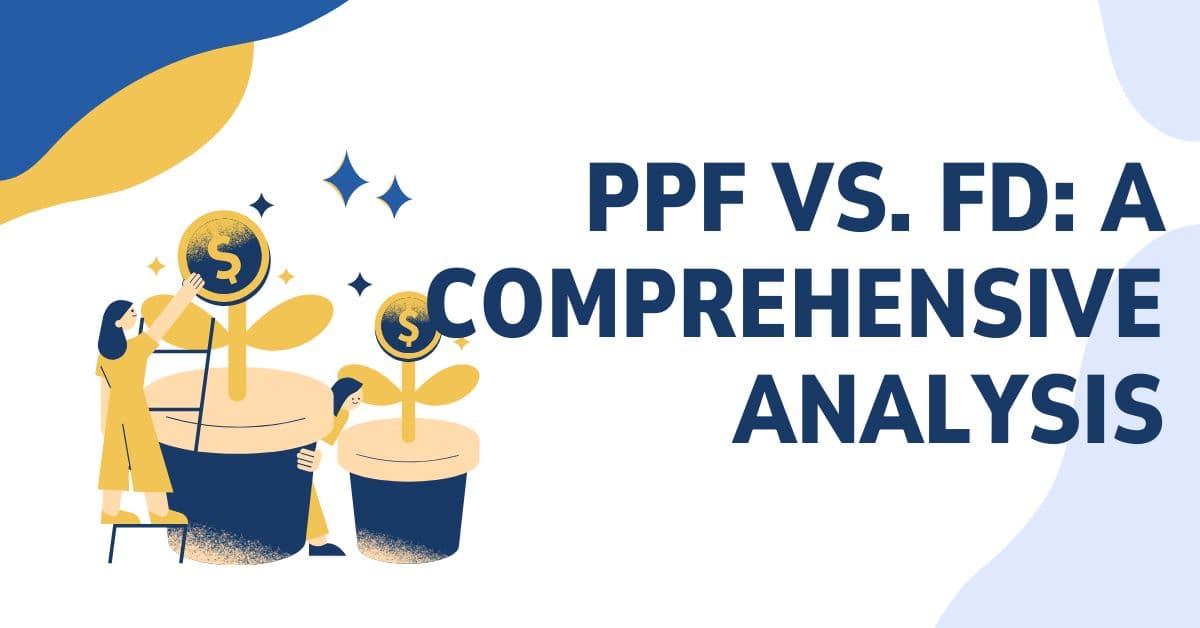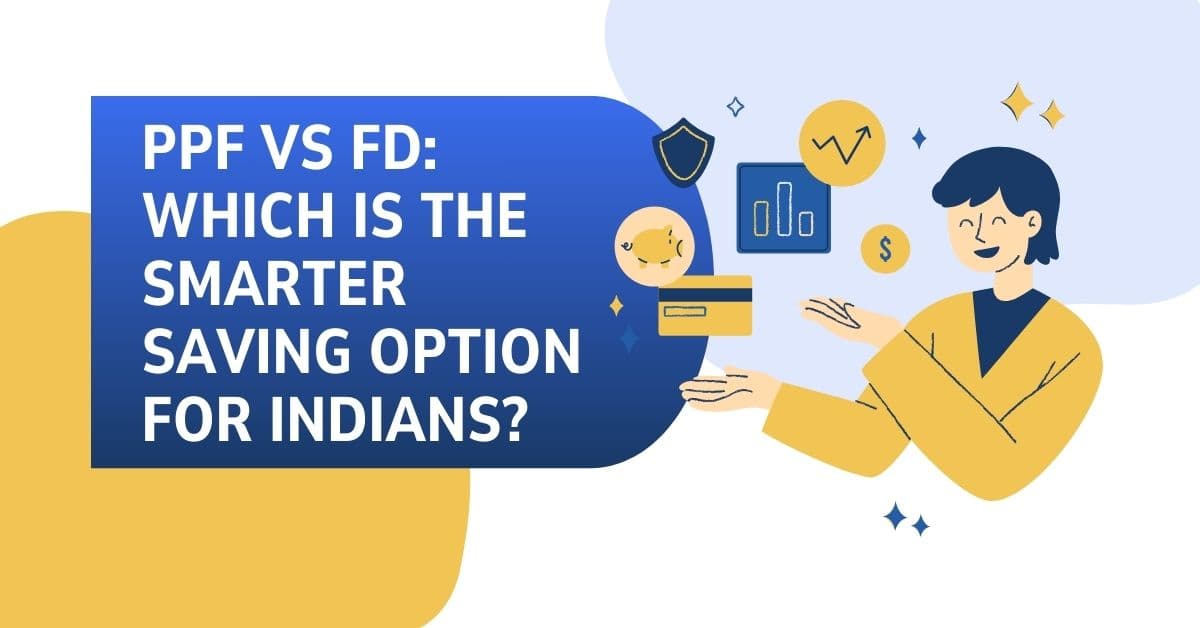PPF vs FD: Which is the Smarter Saving Option for Indians? Selecting the appropriate savings vehicle is essential in India, where millions of people place a high value on wealth accumulation and financial stability. The Public Provident Fund (PPF) and fixed deposits (FDs) are two of the most well-liked choices. Both are low-risk, bank- or government-backed investment options that appeal to Indian investors who are risk averse. The choice between PPF and FD is a crucial financial one because of the substantial differences between them in terms of yields, tax advantages, liquidity, and tenure.
The characteristics, advantages, disadvantages, and applicability for various financial objectives of PPF and FD are thoroughly compared in this guide, which is specifically designed for Indian readers. This article will assist you in choosing the best savings plan for your needs in 2025, regardless of whether you are a young professional, a salaried worker, or a retiree.
What is PPF?
Introduced in 1968, the Public Provident Fund (PPF) is a long-term, government-backed savings plan designed to promote retirement planning and disciplined saving. Post offices, a few banks, and approved financial organisations all throughout India provide it. PPF is especially well-liked because of its assured returns, tax advantages, and alluring interest rates.

Important PPF Features
- Tenure: 15 years, with the option to extend in 5-year increments.
- 7.1% annual interest rate (as of April 2025; subject to government weekly changes).
- The annual investment limit is ₹1.5 lakh, with a minimum of ₹500.
- Tax Benefits: Interest earned and maturity profits are tax-exempt (EEE status: Exempt-Exempt-Exempt), and contributions are eligible for tax deductions under Section 80C up to ₹1.5 lakh.
- Liquidity: loans are accessible from the third to the sixth year; partial withdrawals are permitted after seven years.
- Risk: Since it is supported by the government, there is very little danger.
For whom is PPF the best option? For long-term investors looking for safe, tax-efficient investments for objectives like retirement, kids’ schooling, or wealth accumulation over a period of 15 years or more, PPF is the best option.
What is FD?
Banks and non-banking financial companies (NBFCs) provide fixed deposits (FDs), which are financial products in which you invest a flat sum at a predefined interest rate for a set period of time. Because of their flexible term and consistent yields, FDs are a popular option among conservative Indian investors.
Essential Elements of FD
- Tenure: Vary per bank/NBFC, ranging from seven days to ten years.
- Interest rates range from 5 to 8% annually (as of April 2025), depending on the bank, investor type, and tenure; older persons often receive rates that are 0.25 to 0.5% higher.
- Investment Limits: No higher limit, minimum of ₹1,000 (varies per bank).
- Tax Benefits: The investor’s income tax bracket determines how much interest is taxed. Tax-saving FDs with a five-year term are eligible for up to ₹1.5 lakh in Section 80C deductions.
- Liquidity: Some banks provide flexible FDs with no penalties, however early withdrawals are permitted (with fees).
- Risk: Bank FDs are considered low-risk since they are covered by the Deposit Insurance and Credit Guarantee Corporation (DICGC) up to ₹5 lakh per depositor per bank. NBFC FDs are a little riskier.
Who Must Select FD? FDs are ideal for investors looking for short- to medium-term investments with steady returns for objectives including emergency fund creation, vacation funding, or automobile purchases.
PPF vs. FD: A Comprehensive Analysis
Let’s compare PPF vs FD based on important factors that are important to Indian investors in order to decide which is a better alternative for saving.

1. Rates of Interest
- PPF: Provides a fixed interest rate of 7.1% (effective April 2025), which is subject to quarterly government revisions. Compared to most savings accounts, the interest is greater and typically competitive.
- FD: Interest rates, which normally range from 5% (short-term) to 8% (long-term), differ by bank and duration. Smaller banks or NBFCs could give up to 8% for comparable tenures, although SBI, for instance, provides 6.5–7% for 1–5 years.
Winner: PPF’s rate is more steady and supported by the government, although FDs may win out somewhat for shorter tenures or when NBFCs offer higher rates.
2. Tax Advantages
Triple tax exemption (EEE) is provided by PPF.
- Section 80C allows for the deduction of contributions up to ₹1.5 lakh.
- Earned interest is exempt from taxes.
- The proceeds of maturity are tax-free.
FD: Interest is subject to full taxation in accordance with your income tax bracket (30% for high earners, for example). Section 80C deductions are only available for tax-saving FDs with a five-year lock-in.
Winner: Because PPF is tax-free, it is far better and more appealing to investors in higher tax bands (20–30%).
3. Flexibility and Tenure
- PPF: Required lock-in period of 15 years, with 7-year partial withdrawals. Long-term objectives are well-suited, but flexibility is lacking.
- FD: Customisation according to your objectives is possible with flexible tenures (7 days to 10 years). It is possible to withdraw money too soon, however there may be fines (0.5–1%).
Winner: Because FDs are flexible and can meet short- and medium-term demands, they win.
4. Fluidity
- PPF: Limited resources. After seven years, you can take out up to 50% of the total or borrow against your PPF balance in the third or sixth year.
- FD: Increased liquidity with overdraft or early withdrawal possibilities. For immediate access, several banks provide sweep-in FDs that are connected to savings accounts.
Winner: FDs are preferable for short-term or emergency demands since they are more liquid.
5. Safety and Risk
- PPF: With the support of the Indian government, there is no default risk.
- FD: Bank FDs are secure since DICGC insures them up to ₹5 lakh. Although they are subject to RBI regulation, NBFC FDs are somewhat riskier.
Winner: Although bank FDs are just as safe for the majority of investors, PPF has a little advantage because of its governmental backing.
6. Investment Boundaries
- PPF: Only high-net-worth people may invest, with an annual maximum of ₹1.5 lakh.
- FD: There is no top limit, therefore more investments can be made for bigger objectives.
Winner: For investors with bigger investment amounts, FDs are preferable.
7. Comparison of Returns (Example)
For five years, assuming current rates (PFF: 7.1%, FD: 7% with taxable interest, 30% tax bracket), you invest ₹1 lakh yearly.
PPF:
- ₹5 lakh was invested in total.
- Annually compounded maturity value: around ₹7.06 lakh (tax-free).
- Effective return (all tax-free): ₹2.06 lakh.
FD (Taxable):
- ₹5 lakh was invested in total.
- The quarterly compounded maturity value is around ₹7.02 lakh.
- ₹30,600 is the interest tax (~₹1.02 lakh × 30%).
- Return net: around ₹1.71 lakh.
Winner: Because PPF is tax-exempt, it produces larger post-tax returns.
Which Is Better for Your Financial Objectives, PPF or FD?
Your risk tolerance, investment horizon, and financial goals will all influence your decision between PPF and FD. For Indian investors, here is a breakdown:

Select PPF if:
- You’re making plans for long-term objectives (15+ years), including house ownership, retirement, or your kids’ schooling.
- You are in a higher tax bracket (20–30%) and wish to file tax-free returns.
- You don’t require liquidity for at least seven years, and complete safety is your top priority.
- You’re a small investor or salaried individual trying to get the most out of Section 80C privileges.
For instance, if a professional aged 30 invests ₹1.5 lakh per year in PPF for 15 years, they may amass around ₹40.7 lakh (at 7.1%), which is tax-free and perfect for retirement or a child’s education.
Select FD if:
- You have short- to medium-term (1–5 years) objectives, such as saving for an emergency fund, financing a wedding, or purchasing a car.
- You must both tenure flexibility and cash to cover unforeseen costs.
- Since FDs have no maximum limit, you have a sizable amount to invest.
- You are a senior citizen because banks provide you higher FD rates (an additional 0.25 to 0.5%).
Example: Although interest is taxed, a 25-year-old who saves ₹5 lakh in a 5-year FD at 7% can amass ~₹7.02 lakh, which can be used as a down payment for a car.
Hybrid Method
For diversification, many Indian investors mix FD and PPF:
- For long-term, tax-free wealth accumulation (such as ₹1.5 lakh per year), use PPF.
- Use FDs for emergency cash or short-term objectives (e.g., ₹2 lakh in a 2-year FD).
For instance, a 28-year-old with ₹2.5 lakh to invest can balance tax benefits and liquidity by allocating ₹1.5 lakh to a PPF for retirement and ₹1 lakh to a 3-year FD for a dream vacation.
Challenges and Factors for Indian Investors
1. The rate of inflation
It could be difficult for PPF and FD to beat inflation (4–6% a year). While FDs may yield lower post-tax returns, PPF’s 7.1% rate delivers a true return of about 1% to 3%. If you are willing to take on more risk, think about stocks or equities mutual funds for better returns.
2. Implications for Taxes
Net returns are decreased by the annual taxation on FD interest (TDS is applied if interest exceeds ₹40,000 annually). The fact that PPF is tax-free is a big plus, especially for high earnings.
3. Needs for Liquidity
The 15-year lock-in period of PPF may be a barrier for young investors who want immediate access to capital. Better liquidity is provided by FDs, although early withdrawals may be penalised.
4. Variations in Interest Rates
While FD rates are influenced by RBI policy and market conditions, PPF rates are stable and under government control. To lock in large gains during rate spikes, keep an eye on FD rates.
Resources and Instruments for Indian Investing
- PPF Calculators: To estimate returns, use the online calculators on the websites of SBI, ICICI, or India Post.
- FD Calculators: Websites such as BankBazaar and Paisabazaar facilitate the comparison of FD rates offered by various banks.
- Investment apps: that provide information on PPF and FD choices include Groww, ET Money, and Paytm Money.
- Learning Resources: Go via Zerodha Varsity to learn the fundamentals of investing, or follow Indian financial gurus on YouTube, such as CA Rachana Ranade or Ankur Warikoo.
- Government Portals: For information on PPF and financial literacy initiatives, go to India Post or NSE India.
Conclusion
For Indians, PPF and FD are both great low-risk saving choices; however, which one is best for you will depend on your financial objectives. With unrivalled tax advantages and security for objectives like retirement or education, PPF is the better option for long-term, tax-efficient asset accumulation. FDs offer flexibility and liquidity for objectives like emergency money or holidays, making them perfect for short- to medium-term needs. Your savings plan can be optimised by using a balanced approach that combines FDs for immediate needs and PPF for long-term development.
Call to Action: Assess your financial objectives right now! Open a PPF account with your bank or post office if you want to accumulate money over the long term. Use sites like BankBazaar to compare FD rates for short-term savings.
Chit Fund Saving Groups for Women in Rural India
Smart Money Moves for Govt Job Holders
Smart Saving Tips Every Indian Housewife Must Know

